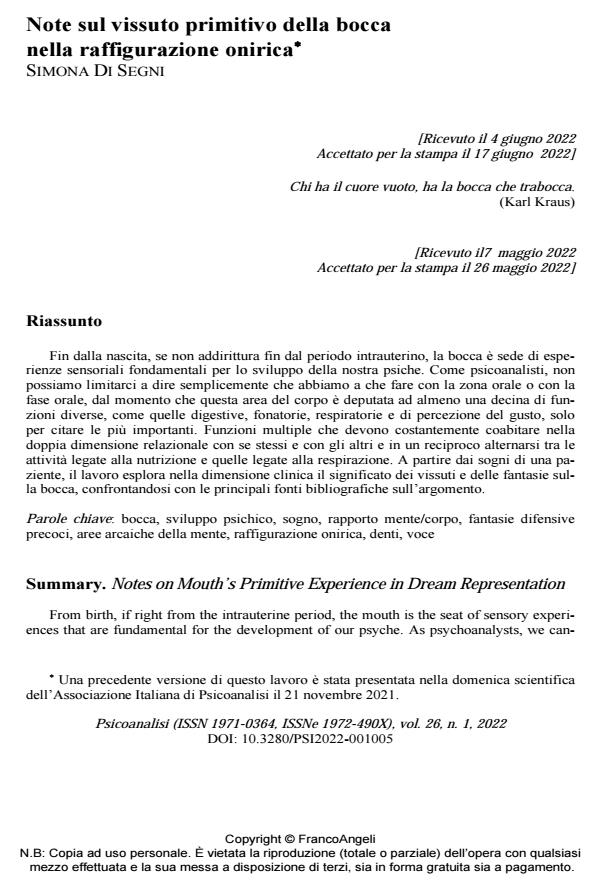Note sul vissuto primitivo della bocca nella raffigurazione onirica
Titolo Rivista PSICOANALISI
Autori/Curatori Simona Di Segni
Anno di pubblicazione 2022 Fascicolo 2022/1
Lingua Italiano Numero pagine 26 P. 47-72 Dimensione file 266 KB
DOI 10.3280/PSI2022-001005
Il DOI è il codice a barre della proprietà intellettuale: per saperne di più
clicca qui
Qui sotto puoi vedere in anteprima la prima pagina di questo articolo.
Se questo articolo ti interessa, lo puoi acquistare (e scaricare in formato pdf) seguendo le facili indicazioni per acquistare il download credit. Acquista Download Credits per scaricare questo Articolo in formato PDF

FrancoAngeli è membro della Publishers International Linking Association, Inc (PILA)associazione indipendente e non profit per facilitare (attraverso i servizi tecnologici implementati da CrossRef.org) l’accesso degli studiosi ai contenuti digitali nelle pubblicazioni professionali e scientifiche
Fin dalla nascita, se non addirittura fin dal periodo intrauterino, la bocca è sede di esperienze sensoriali fondamentali per lo sviluppo della nostra psiche. Come psicoanalisti, non possiamo limitarci a dire semplicemente che abbiamo a che fare con la zona orale o con la fase orale, dal momento che questa area del corpo è deputata ad almeno una decina di funzioni diverse, come quelle digestive, fonatorie, respiratorie e di percezione del gusto, solo per citare le più importanti. Funzioni multiple che devono costantemente coabitare nella doppia dimensione relazionale con se stessi e con gli altri e in un reciproco alternarsi tra le attività legate alla nutrizione e quelle legate alla respirazione. A partire dai sogni di una paziente, il lavoro esplora nella dimensione clinica il significato dei vissuti e delle fantasie sulla bocca, confrontandosi con le principali fonti bibliografiche sull’argomento.
Parole chiave:Bocca, sviluppo psichico, sogno, rapporto mente/corpo, fantasie difensive precoci, aree arcaiche della mente, raffigurazione onirica, denti, voce
- Amati Mehler J. (2014). Fenomeni e oggetti transizionali. Psicoanalisi, 2: 59-78.
- Amati Mehler J., Argentieri S. e Canestri J. (1990; 2003). La Babele dell’inconscio. Lingua madre e lingue straniere nella dimensione psicoanalitica. Milano: Raffaello Cortina.
- Argentieri S. (2011). Sinestesie e multilinguismo. Psicoanalisi, 15, 1: 51-62.
- Barthes R. (1977). The grain of the voice. (S. Heath, trans.). In: Image music text. New York: Hill and Wang, 1972, pp. 179-189.
- Bion W.R. (1962). Learning from Experience. London: Routledge.
- Canestri J. (2003b). Restauro, riconciliazione, riparazione. Psicoanalisi, 7, 2: 175-185.
- Carratelli T.J. (2020). “Tenere l’infinito nel palmo di una mano e l’eternità in un’ora…”. Su alcuni processi sorgivi della psiche tra umano e non umano. Psicoanalisi, 24, 2: 80-89.
- Easson W.M. (1973). The earliest ego development, primitive memory traces, and the «Isakower phenomenon». Psychoanal. Q. 42: 60-67.
- Ferretti Levi Montalcini A. (1997). Sulla imitazione di Eugenio Gaddini: elementi di una discussione. Psicoanalisi, 1, 2: 171-181.
- Freud S. (1938). Compendio di Psicoanalisi. In: Opere Vol XI: 569-636. Torino: Bollati Boringhieri.
- Gaddini E. (1959). La ruminazione nell’infanzia. In: Scritti. 1953-1985. Milano: Raffaello Cortina.
- Gaddini E. (1969). Sulla imitazione. Psicoanalisi, 1, 2: 135-157.
- Greenacre P. (1958). Toward an Understanding of the Physical Nucleus of Some Defence Reactions. Int. J. Psychoanal. 39: 69-76.
- Hoffer W. (1949). Mouth, Hand and Ego-Integration. Psychoanal. Study Child, 3: 49-56.
- Hoffer W. (1950). Development of the Body Ego. Psychoanal. Study Child, 5: 18-23.
- Isakower R.O. (1938). A contribution to the pathopsychology of phenomena associated with falling asleep. Int. J. Psychoanal., 19: 331-345.
- Lewin B. (1946). Sleep, the mouth, and the dream screen. Psychoanal. Q., 15: 419-434.
- Lewin B. (1948). Influences from the dream screen. Int. J. Psychoanal., 29: 224-231.
- Lewin B. (1953). Reconsideration of the dream screen. Psychoanal. Q., 22: 174-199.
- Maiello S. (1995). The sound-object: A hypothesis about prenatal auditory experience and memory. Journal of Child Psychotherapy, 21, 1: 23-41.
- Maiello S. (2006). One mouth and two breasts – The ground plan of triangulation: a baby fed on one breast only. Infant Observation, 9:1, 73-89. DOI: 10.1080/13698030600594003
- Maiello S. (2010) À l’aube de la vie psichique. Réflexions autour de l'objet sonore et de la dimension spatio-temporelle de la vie prénatale. In: Joyce Aïn, Réminiscences. Érès: pp. 103-116 --https://www.cairn.info/reminiscences---page-103.htm.
- Meltzer D., Williams M.H. (1988). The Apprehension of Beauty. London: HMT and Karnac, 2008.
- Moore B.E., Fine B.D. (1990). Psychoanalytic Terms and Concepts. New Haven: Yale Univ. Press.
- Piontelli A. (1987). Infant Observation from Before Birth. Int. J. Psychoanal. 68: 453-463.
- Prechtl F.R. (1984). Continuity of neural functions from prenatal to postnatal life (Heinz F.R., Prechtl). Oxford: Blackwell Scientific.
- Sperling O.E. (1957). A psychoanalytic study of hypnagogic hallucinations. J. Am. Psychoanal. Assoc. 5: 115-123.
- Spitz R.A. (1955). The primal cavity: A contribution to the genesis of perception and its role for psychoanalytic theory. Psychoanalytic Study of the Child, 10: 215-240.
- Spitz R.A. (1959). La cavité primitive. Rev. fr. psychanal., 23, 2: 205-234.
- Tustin F. (1986). Autistic barriers in neurotic patients. New Haven, ct: Yale University Press.
- Trevarthen C. (2005). First things first: infants make good use of the sympathetic rhythm of imitation, without reason or language. Journal of Child Psychotherapy, 31: 91-113.
Simona Di Segni, Note sul vissuto primitivo della bocca nella raffigurazione onirica in "PSICOANALISI" 1/2022, pp 47-72, DOI: 10.3280/PSI2022-001005